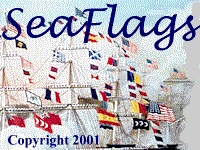
 |
Flagstaff Ornaments |
The United States Navy and Coast Guard are unique among the American armed forces in using different flagstaff ornaments, also known as finials, atop the staffs of both the ensign (or national color) and the personal flag of an official or officer depending on his or her rank. This practice originated as a way of distinguishing between commanding officers embarked in boats who were of different ranks. While all flag officers displayed their rank flags, commanding officers below flag rank all displayed the commission pennant in the bow of the boat, making it difficult to distinguish between a captain, a commander, and a lieutenant commander--a matter of considerable protocolary consequence.
The battle-ax ornament is used only atop the national
color used for ceremonial purposes or displayed ashore, the Navy Flag,
and the naval infantry battalion flag. It should not be confused
with the halberd ornament (see below).
The Navy uses this spread eagle finial atop the
staffs of the boat ensigns and personal flags used by officials and officers
entitled to an official salute of 19 or more guns: the President,
the Vice President, the Secretary of Defense, the Secretary of the Navy,
the Chief of Naval Operations, and fleet admirals. It tops the ensign
staff in boats occupied by other U.S. officials of equivalent rank, and
both the ensign staff and jack staff of a boat carrying the chief of a
U.S. diplomatic mission. This finial is also used atop the personal
flags of the Secretary of Defense, the Secretary of the Navy, and the Chief
of Naval Operations that are displayed in their respective offices.
The President's flag as displayed at the White
House and in joint service ceremonies is topped by a different pattern
of eagle from the standard Navy version. The eagle looks to his right
rather than straight ahead and the wings are displayed inverted in a Roman
style rather than spread back as on the Navy pattern. This same finial
is frequently used atop the national flag as displayed in many government
offices as well as on other official's flags (including the Vice
President's and Secretary of
Defense's, although the Navy-style spread eagle
is used on the flag in the Secretary of Defense's office).
The halberd is used for the flagstaffs of flag
officers other than the CNO and fleet admirals and for civil officials
entitled to a salute of at least 11 but not more than 17 guns. This
ornament was used in the US Navy at least as early as 1853, when Japanese
paintings show it topping the staff on which Commodore Matthew C. Perry's
broad pennant was carried in processions during his expeditions to Japan.
Nevertheless, the 1920 Navy Regulations stipulated the use of a
lance head finial for flag officers' flagstaffs. The use of the halberd
was restored with official blessing in a change to Navy Regulations issued
on December 28, 1935.
The ball is used for the boat flagstaffs (both
ensign and commission pennant) of captains and officers of equivalent rank,
and for career ministers, counselors, and first secretaries of U.S. diplomatic
missions abroad. The use of the ball to represent a commanding officer
in the grade of captain was first decreed in the 1876 Regulations for
the Government of the Navy.
The star finial is used for the boat flagstaffs
of commanders and officers of equivalent rank. The use of the star
for this purpose was first decreed in the 1876 Regulations for the Government
of the Navy.
The
flat truck is simply the lower portion to which the ornaments above (except
the battle-ax) are fastened. It is the sole ornament atop the flagstaff
for officers below the rank or relative rank of commander and for civil
officials not listed above for whom honors are prescribed by U.S. Navy
Regulations.
The spearhead finial is used for Navy guidons
and for all colors, guidons, and personal flags by the Marine Corps, Army,
and Air Force.
Sea
Flags
Copyright 2000, 2001 by Joseph
McMillan